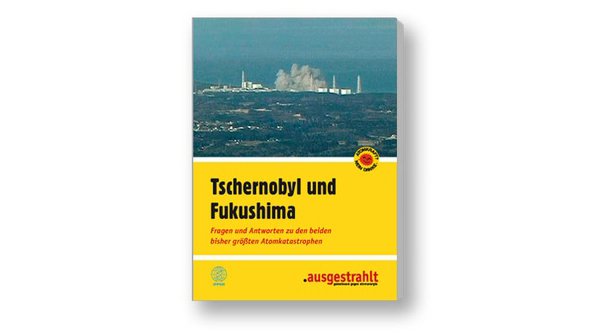
Tschernobyl und Fukushima
Fragen und Antworten zu den beiden bisher größten Atomkatastrophen. »
klickbare Quellenhinweise aus der Broschüre
1 Fairlie, The other report on Chernobyl, 2006
2 IPPNW, Gesundheitliche Folgen von Tschernobyl, 2011
3 UN, Dokument A/50/418, 8.9.1995
4 IPPNW, Gesundheitliche Folgen von Tschernobyl, 2011
5 Nyagu, The current situation in Ukraine, 2006
6 IPPNW, Gesundheitliche Folgen von Tschernobyl, 2011
7 Mousseau, The Chernobyl + Fukushima Research Initiative, Summary, 2014
8 IPPNW, Gesundheitliche Folgen von Tschernobyl, 2011
9 IPPNW, Fukushima: Tsunami-Legende, März 2012
10 Sadiq, An overview of current knowledge concerning the health and environmental consequences of the Fukushima Daiichi Nuclear Power Plant (FDNPP) accident, 2015
11 Stohl, Xenon-133 and caesium-137 releases into the atmosphere from the Fukushima Dai-ichi nuclear power plant, 2012
12 TEPCO, The resulting (and projected) effects brought by purificatioon and drainage of pumped underground water, 25. August 2014
13 IRSN, Synthèse actualisée des connaissances relatives à l’impact sur le milieu marin des rejets radioactifs du site nucléaire accidenté de Fukushima Dai-ichi, 26. Oktober 2011
14 Woods Hole Oceanographic Institution (WHOI), Researchers Assess Radioactivity Released to the Ocean from the Fukushima Daiichi Nuclear Power Facility, 6. Dezember 2011
15 IAEA, Worldwide marine radioactivity studies, Radionuclide levels in oceans and seas, 2005
16 MEXT, Notification of interim policy regarding decisions on whether to utilize school buildings and outdoor areas within Fukushima Prefecture, 19. April 2011
17 New York Times, 25. Mai 2011
18 Human Rights Now, Investigative Report on Fukushima City and Koriyama City Fact-finding mission conducted on November 26 and 27, 2011 (S. 19), Dezember 2011
19 Spiegel Online, 9. Oktober 2015
20 NAIIC, The official report of The Fukushima Nuclear Accident Independent Investigation Commission (NAIIC) of the National Diet of Japan Executive Report, 5. Juli 2012 (S. 18‑19)
21 Spiegel Online, 9. Oktober 2015
22 IAEA, Fukushima Nuclear Accident Update, 12. März 2011
23 IPPNW, Critical Analysis of the UNSCEAR Report „Levels and effects of radiation exposure due to the nuclear accident after the 2011 Great East-Japan Earthquake an tsunami“, 5. Juni 2014
24 Ministry of Education, Culture, Sports, Science and Technology Japan, Extension Site of Distribution Map of Radiation Dose etc., November 2011
Proll, Japan aktuell: Radioaktives Cäsium erreicht weite Landesteile Japans, 21. November 2011
25 Sato, Vortrag auf der NURIS-Konferenz, April 2015
26 IPPNW, Critical Analysis of the UNSCEAR Report „Levels and effects of radiation exposure due to the nuclear accident after the 2011 Great East-Japan Earthquake an tsunami“, 5. Juni 2014
UNSCEAR, 2013 Report, Levels and effects of exposure due to the nuclear accident after the 2011 great east-Japan earthquake and tsunami, 2014 (S. 186, § C92 und S. 255, § E43)
27 IPPNW, Critical Analysis of the UNSCEAR Report „Levels and effects of radiation exposure due to the nuclear accident after the 2011 Great East-Japan Earthquake an tsunami“, 5. Juni 2014
28 Ministry of Health Labour and Welfare Japan, Sum up of radionuclide test results reported in FY2015, 30. November 2015
29 Foodwatch/IPPNW, Grenzwerte für die Strahlenbelastung von Lebensmitteln, 20. September 2011
30 IPPNW, Jeden Monat neue Schilddrüsenkrebsfälle, Dezember 2015
31 3Sat, Programmhinweise zur Dokumentation „Tabu Kernforschung“ am 29. Oktober 2015
32 Focus 15/2011, Interview mit THW-Präsident Albrecht Broemme
33 Deutsche Risikostudie Kernkraftwerke, Phase B
34 Focus online, 18. Mai 2011
35 .ausgestrahlt, Hintergrund Katastrophenschutz, 30. Juli 2014
36 Ewers, Abschätzung der Schäden durch einen sogenannten „Super-GAU“, 1992
37 BfS, Analyse der Vorkehrungen für den anlagenexternen Notfallschutz für deutsche Kernkraftwerke basierend auf den Erfahrungen aus dem Unfall in Fukushima, 2012

